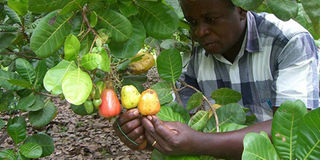Explore cashew nut for better pay

A farmer harvests cashew nut pods. Courtesy Photo
Cashew tree, also known as Anacardium occidentale, belongs to the family of Ancardiacea that includes, among others, mango fruit and Pistacio nuts.
The plant originates from the Caribbean Islands and the north east of Brazil.
In a 2017 publication by Away4 Africa about cashew value chain in Uganda, it is stated that cashew nuts can grow potentially in all ecological zones of the country.
Better yields are obtained by an annual rainfall of 800-1200 mm and an extended dry season to allow flowering and fruiting.
Cashew trees prefer tropical climate with high and constant temperature and with enough sunlight for high yields. Dry spells do not affect the cashew as a perennial crop, as they do with the annual crops. In a period of climate change, where the unreliability of rainfall is increasing, the yields from cashew contributes to the resilience of the farming system in most of the zones in Uganda. In areas with more rainfall insect and pest pressure affects the quality of the nuts, producing spotted nuts and favours decay of the kernels, once affected.
Pests and diseases
The air humidity above 85 per cent leads to vulnerability to Powdery Mildew Disease, a fungal attack to tender leaves, flowers, young nuts and fruits resulting in drying and aborting of flowers.
The cashew tree is generally pest free if it is in good health. Major pests that attack it are tea mosquito, stem and root borer plus leaf miner which can be avoided by growing hybrid varieties which are disease resistant.
Experts cite in the publication that rural people in northern and eastern Uganda face food insecurity therefore integration of the cashew nut tree as a perennial cash crop seems to be an opportunity to increase farmer income.
A value chain analysis from production to marketing will position the market opportunity for the plant and farmers to gain increased income.
Seeds of Gold had the opportunity to interview Hellen Betty Acham, a farmer growing cashew. Acham is also the chairperson of cashew farmers association in the region.
Agronomy
Acham, who is an agriculturalist by profession, explains that the crop is a high value nutrient crop and a good source of protein, magnesium, potassium, iron, and zinc which is good for human health.
She owns seven acres of cashew where she has so far harvested twice. “Cashew is a plant which can be harvested continuous as long as good agronomy practice is maintained,” Acham says. Provision of bee hives around the farm is important for pollination to take place. Acham and team have mobilised about 3,600 farmers in the region who have planted about 167,000 cashew trees. The farmers in central Uganda growing the crop comprise 6,500 with 11,678 trees in central region and 164,020 new tree have been planted across the country. The total acreage of land covered with cashew is 2,665 producing 25 metric tonnes per year.
Market
According to Acham, there is clear demand for white roasted and unroasted cashew nut kernels with super markets and hotels in Kampala importing from Tanzania and Kenya 50 and 100 metric tonnes respectively per year. The team has established 25 demonstration sites across east and north for farmer sensitisation about practices of growing the crop with 48 nursery operators.
At the moment there are one million seedlings on ground for sell by nursery operators with each seedling sold at Shs3,000.
Varieties
Acham says that the hybrid varieties grown by the farmers are AC4, AC3, AZA, AC17 and local variety Esegu. Most farmers engaged in growing the plant have at least 40 trees on farm with yield potential of 10-15 kilogrammes per acre.
Agronomy
The nut-trees should be planted in rows and for farmers practicing intercropping the seeds are planted 12cm by 12cm but for those not practicing intercropping the spacing is eight by eight centimetres.
The plant is ready for harvesting three years ready for harvesting. Farmers can intercrop it with any crop, such as maize, beans, groundnuts and other vegetables through the growth period. Cashew tree needs regular application of fertiliser to thrive and produce fruits.
Farmers are advised to use slow-release fertiliser with N-P-K 8 according to the product instructions given on the packet, around the base of the tree every two months during the growing season.
It is important to apply compost or farm manure once in a year, around 15 kilogrammes on the surface of the soil to a mature tree.
Pruning and mulching
Prune cashew trees regularly to remove weak, dead and entangled branches and branches that are infested with diseases or pests. Cut overcrowded branches to promote vigorous growth. It is important to carry out mulching around your cashew tree with organic matters to prevent weeds and to conserve moisture.
Harvesting
Farmers are expected to harvest when cashew apples turn pink or red and cashew nut shells are gray. After harvesting, separate the cashew apple from the nut. It should be dried up to 0.8 per cent moisture content. Cashew apple can be eaten raw or make juice out of it. Unshelled cashew nut can be stored up to two years. Do not attempt to break the shell before roasting; cashew shell contains very caustic oil which can the burn skin.
Planting
The seedlings are raised from its seed and Acham and other seedling producers purchase the seed from Tanzania with each kilogramme costing $15 (about Shs55,000).
The seeds are planted in seed beds or containers and transplanted after three months.
To prepare the soil for planting, mix the nursery soil with compost.
The seed bed’s soil should be fine, with all sticks and stones removed. It should be raised about 15 cm above the surrounding area.




